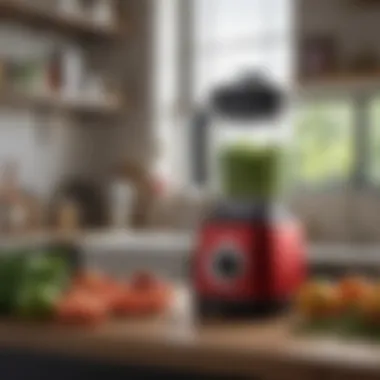Affordable Blenders Under $50: Expert Insights


Intro
The modern kitchen is incomplete without a versatile blender, a tool that saves time and enhances culinary experiences. For many, the quest for a quality blender often leads to the daunting prospect of high prices. However, an abundance of options exists for those on a budget. Blenders priced under $50 can deliver significant functionality without financial strain.
This guide aims to demystify affordable blenders, providing insight into their features, performance, and usability. By examining various models, it will assist consumers in making informed choices that align with their specific culinary needs.
In the following sections, we will compare top models, consider user requirements, and explore maintenance tips, all while assessing the value these budget-friendly blenders provide.
Thorough analysis of blenders under $50 can transform how you approach your kitchen tasks, offering both satisfaction and efficiency within the constraints of a limited budget.
Features to Consider When Buying a Budget Blender
When selecting a budget blender, it is essential to know which features to prioritize. Here are some significant criteria to keep in mind:
- Power: Look for wattage; a higher wattage usually indicates better performance.
- Blades: Stainless steel blades often provide durability and better blending results.
- Capacity: Consider the jar size based on your consumption needs. A capacity of 32oz to 48oz is common for households.
- Speed Settings: Multiple speed settings enhance versatility, allowing for different textures and consistency.
- Ease of Cleaning: Blender jars that are dishwasher safe are an advantage, simplifying maintenance.
Affordable does not always mean compromising on quality. It is possible to find blenders that perform well without breaking the bank.
Performance Testing of Popular Models
To understand how budget blenders perform, let’s analyze a few models that are popular in the under $50 category:
- Ninja Personal Blender: Known for its compact size, it excels in smoothie-making. It includes to-go cups, which is a convenient feature.
- Hamilton Beach Power Elite Blender: This model offers a unique wave action system that pulls ingredients down for smoother results. It is versatile for various cooking tasks.
- BLACK+DECKER FusionBlade Blender: This blender is appreciated for its lightweight design and powerful motor. It is suitable for daily use and allows for quick blending tasks.
Each of these models offers unique advantages. Performance can vary significantly, based on individual needs and preferred culinary tasks. A thorough review of user feedback is beneficial before making a purchase.
User Considerations
When selecting a blender, users must reflect on their individual needs. Here are some factors that may affect your decision:
- Culinary Goals: Are you making smoothies, soups, or sauces? Knowing your primary use case helps narrow down choices.
- Frequency of Use: If you plan to use the blender daily, durability and power should be prioritized.
- Kitchen Space: Compact blenders might suit smaller kitchens better.
By understanding these aspects, users can choose a model that aligns well with their lifestyle.
Maintenance Tips for Longevity
Proper maintenance extends the life of your blender. Here are several practical tips:
- Regular Cleaning: Clean the blender after each use. For stubborn residue, fill the jar with warm water and a drop of dish soap, blend, and rinse.
- Avoid Overloading: Following the manufacturer's guidelines on ingredient capacity prevents motor strain.
- Store Properly: Keep the blender in a dry place, away from moisture.
Adhering to these maintenance measures can enhance performance and ensure longevity in budget blenders.
Culmination
Exploring options for blenders under $50 reveals a market filled with practical choices that do not compromise on effectiveness. By investigating various models, understanding user needs, and adhering to maintenance best practices, consumers can make sound decisions in selecting the right blender for their kitchen. This guide strives to empower readers in their purchases, fostering a more enjoyable culinary experience within budget constraints.
Prelude to Affordable Blenders
In the world of kitchen appliances, blenders are pivotal for many culinary tasks. They are used by food lovers to prepare smoothies, soups, sauces, and more. The affordability of blenders, especially those priced under $50, makes them accessible to a broad audience. This section explores the relevance and significance of affordable blenders, uncovering why they have become a staple in modern kitchens.
Affordable blenders combine functionality with budget-friendliness, making them ideal for various consumers. Those who cook regularly or occasionally can benefit from having a basic blender that meets their needs without overspending. In addition, understanding the available options in this price range allows consumers to make informed choices based on personal preferences and culinary requirements.


Here are some key points to consider regarding affordable blenders:
- Diverse functionality: Most blenders under $50 can perform multiple tasks, such as blending, chopping, and pureeing. This versatility is valuable for anyone looking to create different types of meals.
- User-friendly design: Many budget models prioritize ease of use. This accessibility is crucial for novice cooks or those who prefer simple, straightforward appliances.
- Compact size: Often, budget blenders are smaller and easily stored, making them suitable for kitchens with limited space.
- Emerging features: While more advanced blenders often come with bells and whistles, many affordable models now include features like pulse settings and various speed options, enhancing their usability.
"Choosing a blender should not be a daunting task. With a little research, anyone can find a suitable model."
Ultimately, understanding affordable blenders helps consumers appreciate what is available without needing to spend a fortune. By the end of this guide, readers will have a better grasp of how to select the right blender that meets their unique needs while ensuring quality and performance are not compromised.
The Importance of Choosing the Right Blender
Selecting an appropriate blender has direct implications on culinary adventures. The choice of model can affect everything from meal preparation time to the quality of your smoothies or soups. Investing in the right device ensures that one can execute various tasks efficiently, supporting creativity in the kitchen.
First, consider the versatility that comes with a suitable blender. A good blender can effortlessly manage multiple tasks such as pureeing, chopping, and grinding. For example, if you enjoy making smoothies, a model with enough power can crush ice and frozen fruit, delivering a smooth consistency. On the other hand, if your interest lies in soups or sauces, a blender that can handle hot liquids is essential. A poor choice may lead to frustration, resulting in chunks rather than a desirable texture.
Moreover, the quality and durability of a blender are critical factors to contemplate. Cheaper models may not withstand regular use, leading to premature failures. Investing in a reliable product that supports long-term use becomes justifiable. Not all models under $50 are created equal. It is vital to research and compare to pinpoint a blender that balances cost and performance, establishing a healthier approach to your cooking habits.
When it comes to considerations for the right blender, it is also necessary to factor in ease of use and cleaning. Users will likely appreciate a blender that operates intuitively and cleans up with minimal fuss. A complex model with many attachments and settings might intimidate novice cooks, causing them to shy away from using it.
"Choosing a blender is not just about picking the cheapest option. It's about identifying a tool that enhances your cooking experience."
Key Features to Look for in a Blender
Understanding the key features of blenders is crucial for making an informed purchase decision, especially in the budget category. Consumers must focus on specific elements that ensure functionality. Each feature contributes to the overall performance, usability, and satisfaction with the product. In the context of blenders priced under $50, essential attributes like motor power, blade quality, capacity, material durability, and ease of cleaning become even more significant. Consumers should not only consider these features individually but also understand how they work together to create a well-rounded product.
Motor Power
Motor power is fundamental in a blender. It directly influences how well the device can handle various tasks. A high-wattage motor can blend tougher ingredients like frozen fruits or vegetables with ease. Most budget blenders have motors ranging from 300 to 700 watts. While some may think higher power guarantees better performance, it’s essential to align the motor’s wattage with intended use. For simple tasks like smoothies or basic sauces, a motor in the 400-500 watt range often suffices. However, more ambitious culinary tasks may warrant a higher wattage.
Blade Quality
The quality of blades is another pivotal aspect to consider. Stainless steel blades offer durability and efficient cutting. These blades must be sharp to ensure smooth blending. A well-made blade can handle ice and fibrous vegetables, reducing prep time. Furthermore, two or more blades can improve blending efficiency, ensuring a more consistent texture. Consumers should inspect designs as well; certain configurations help in generating a vortex that pulls ingredients towards the blades. By focusing on these factors, buyers can make a sound investment.
Capacity
Capacity refers to how much liquid or food a blender can hold at one time. This feature often goes hand-in-hand with user needs. Smaller models, typically under 32 ounces, are perfect for individuals or couples but may require multiple batches for larger families. On the other hand, larger capacities, up to 64 ounces or more, offer the convenience of preparing larger batches. Potential buyers should consider their regular blending tasks when selecting the capacity.
Material Durability
The materials used in a blender's construction play a crucial role in its longevity. Plastic bases are common in budget blenders, but it's important that they are of high quality to prevent cracking or warping. Glass containers, while heavier, are aesthetically appealing and resistant to scratches. Rubber or silicone gaskets contribute to effective sealing. Evaluating material durability can prevent future mishaps and disappointments, ensuring that buyers do not frequently replace their devices.
Ease of Cleaning
Cleaning convenience is an often-overlooked feature that can significantly affect the user's experience. Blenders with removable blades or dishwasher-safe containers simplify the cleaning process. Some models may also offer a self-cleaning function, which can be particularly useful for busy individuals. A blender that is difficult to clean can deter users from making nutritious smoothies or soups due to preparation time. Therefore, contemplating ease of cleaning can lead to a more enjoyable and practical use.
Comparison of Popular Models Under $50
When selecting a blender, especially those priced under $50, it is crucial to analyze specific models. Each model carries different strengths and weaknesses. The importance of comparing these models lies in understanding their performance, build quality, and applicability to your own culinary needs.
Your needs might vary depending upon daily usage or specific tasks like making smoothies, soups, or sauces. By comparing popular models, you empower yourself with insights into what complements your lifestyle while remaining budget-friendly. This exploration will help you avoid poor choices while gaining knowledge about the features that matter the most.
Model A Performance Review


Model A is a well-regarded option in the under $50 category. It has a 600-watt motor, which is sufficient for basic blending tasks. Users commend its efficiency in crushing ice and blending fruits into smooth textures. Its stainless-steel blades ensure consistent results.
The design is also user-friendly, featuring simple controls that make operation straightforward. However, the plastic pitcher may raise concerns about longevity compared to glass alternatives. Although this model functions satisfactorily for daily tasks, it may struggle with harder ingredients like nuts.
Model B Performance Review
Model B differentiates itself with a slightly lower motor power of 500 watts. Despite its lesser power, it is adept at making creamy smoothies and soups. One highlight is its compact size, which makes it suitable for kitchens with limited counter space. The glass pitcher contributes to the aesthetics, but it also makes the model heavier.
Users have reported mixed experiences with ice crushing, where results might vary. Nonetheless, for individuals primarily focused on softer ingredients, it serves as a reliable choice. The pricing remains competitive, making it a valid option for those adhering to a tight budget.
Model Performance Review
Model C stands out with a robust 800-watt motor, making it the most powerful in our comparisons. This model excels in handling tougher tasks such as nut butter preparation or puréeing fibrous vegetables. Its larger capacity allows for blending larger batches, which is ideal for families or meal prep enthusiasts.
Despite its strength, some users note that the noise level is quite high during operation, which might be a concern if you prefer quieter appliances. Furthermore, the design includes a durable glass jar, enhancing its longevity. However, ease of cleaning might not be best due to the complexity of its assembly.
User Considerations When Selecting a Blender
When selecting a blender, consumers should consider multiple factors to ensure their choice aligns with specific needs and lifestyle. This section will help to focus on key elements such as intended use, frequency of use, and kitchen space. Evaluating these components allows for a more informed decision, ensuring satisfaction with a purchase under $50.
Intended Use
The first step in choosing a blender is understanding its intended use. Different blenders serve varied purposes. Some users may need a blender primarily for smoothies, while others might require it for soup, sauces, or even nut butter. Consideration of what you'll blend most often guides the selection process. If making thick smoothies or breaking down tough ingredients is a priority, a more powerful motor is essential. On the other hand, occasional use for light mixing might only require a basic model. Thus, identifying your goals plays a crucial role in making the right choice.
Frequency of Use
Next, think about how often you plan to use the blender. Frequent users need a more durable and high-performance model that can withstand daily use. A budget model may not hold up well over time for someone blending several times a day. Analyzing usage patterns helps clarify whether an economical choice will be adequate or if investing slightly more would yield better longevity. Think about purchasing a model specifically designed for everyday use if you blend daily or several times a week.
Kitchen Space and Storage
Lastly, kitchen space and storage are practical considerations. Blenders can vary significantly in size, and finding a model that fits your kitchen's layout is crucial. Users who have limited counter space should seek compact designs that can be easily stored away when not in use. If space permits, a more robust model could be more beneficial.
“A well-selected blender should not only perform well but also fit seamlessly into your kitchen environment.”
In summary, assessing these user considerations enhances the decision-making process. Each individual's needs differ, but by focusing on intended use, frequency of use, and kitchen space, consumers can find a blender that not only fits their budget but also meets their daily culinary demands.
Common Limitations of Budget Blenders
When exploring blenders in the under $50 category, it is crucial to recognize their common limitations. Understanding these restrictions helps consumers make informed decisions, ensuring they align their expectations with the actual capabilities of these machines. Many budget blenders can excel at basic tasks, yet they often come with trade-offs that savvy consumers should consider before purchasing.
Power Restrictions
One of the most significant limitations of budget blenders is their power output. Typically, models priced below $50 come with lower wattage motors. This can affect their ability to blend tougher ingredients, such as frozen fruits or fibrous vegetables. While many will manage smoothies and soups quite well, if your culinary ambitions include making nut butters or breaking down ice for cocktails, you might find a budget blender quite inadequate.
The power of a blender is measured in watts, and many models in this price range hover around 300 to 600 watts. Some may struggle to achieve a consistent blend, leading to uneven textures. For tasks requiring precision, this may pose a limitation. Thus, it’s essential to consider what types of recipes you intend to prepare before settling on a specific model.
Durability Concerns
Another common drawback of budget blenders lies in their durability. The materials used in these devices are often less robust than those in higher-end models. Plastic containers may be lightweight, but they can also be prone to scratches and cracks over time. Regular use may lead to wear and tear, compromising not only performance but also safety.
Moreover, the longevity of the blender's motor can be an issue. High heat and strain from heavy blending tasks can lead to motor burnouts. Many consumers have experienced premature failure of budget blenders after only a few months of regular use.


In summary, while budget blenders can be functional, they do come with limitations that users should evaluate against their specific blending needs. Knowledge of these limitations regarding power restrictions and durability concerns will empower consumers to choose wisely. It also ensures that they have realistic expectations about what their blender can achieve.
Maintenance Tips for Longevity
Maintaining a budget blender can seem simple enough, but effective upkeep is crucial for maximizing its lifespan and performance. Blenders under $50 can provide great service if cared for properly. Ignoring maintenance can lead to reduced performance, increased wear, and eventual malfunction. Consequently, following maintenance tips not only enhances the user experience but also prolongs the device's operational life.
Regular Cleaning Practices
Cleaning blenders after use is essential for preventing residue buildup, which can hamper both performance and taste. After blending, it’s best to disassemble components. Rinse the blending jar and blades under warm water to remove stuck ingredients immediately. For a deeper clean, you can blend a mixture of warm water and a drop of dish soap at low speed. This method effectively cleans remaining residue without damaging the motor.
It’s also important to pay attention to the lid and any removable seals. These parts can trap food particles if not cleaned thoroughly. Air drying these components completely is recommended to prevent mold growth. Establishing a routine cleaning schedule can prevent any buildup that might affect your appliance.
Proper Storage Techniques
The way you store your blender can greatly affect its longevity. Keeping it in a dry and cool area prevents moisture accumulation and potential corrosion. If you frequently use your blender, leaving it on the counter is fine. However, if it is used less often, consider storing it in a cabinet. This keeps it out of direct sunlight that can affect materials over time.
For optimal storge, make sure to keep the blender assembled only when in use. Disassembling it when storing can save space and prevent accidental damages while reaching for other items in your kitchen. Always ensure that the power cord is not twisted or under heavy objects to avoid damage.
Tip: Always refer to the blender’s manual for specific cleaning and storage instructions to avoid voiding warranties or damaging parts.
By incorporating these maintenance tips into your routine, you can ensure that your budget blender continues to perform effectively and reliably while serving delicious recipes for years to come.
Value for Money: Is it Worth It?
When considering a blender under $50, the question of value for money becomes paramount. Consumers often wonder if they can find a product that balances affordability with functionality. This section will analyze the benefits and considerations of choosing budget blenders, emphasizing why understanding value for money is crucial in this price segment.
The phrase "value for money" encapsulates the idea that the benefits received from a product should at least equal, if not exceed, the amount spent on it. In the context of affordable blenders, this can mean assessing performance, durability, and features in relation to their price. A key advantage of these models is their accessibility. They present a practical option for individuals or families looking to enhance their kitchen experiences without straining their budgets.
Cost Versus Performance Ratio
A vital part of understanding value for money is the cost versus performance ratio. This ratio reveals how well a blender performs relative to its price. Many blenders under $50 may not have the same reliability as higher-end models, but several options can perform surprisingly well for standard tasks.
- Functionality: Look for blenders that can handle basic tasks. Smoothies, soups, and sauces are commonly made, and many budget models can manage these without trouble.
- User Reviews: Feedback from other consumers plays an essential role. Assessing reviews can help identify which models deliver good performance relative to cost.
- Specifications: Check for motor power, blade quality, and additional features in models under $50. Some possess satisfactory specifications that make them worth the purchase.
Ultimately, the goal is to find a balance. A low-cost blender may limit some capabilities but could still provide significant value for occasional use, especially for those new to cooking or blending.
Long-term Investment Perspective
While the initial purchase price is important, viewing a budget blender as a long-term investment can alter the decision-making process. A blender costing less than $50 is often treated as more of a short-term tool. However, some considerations can provide a different perspective on longevity and overall investment.
An important factor is durability. Many affordable blenders are designed with cost-effective materials, which may lead to questions about their lifespan.
- Usage Frequency: Consider how often the blender will be used. For someone who plans to blend daily, a slightly higher investment may be wise. Conversely, for occasional users, cheaper options may suffice.
- Repair and Maintenance: Understanding the repair options and parts availability also matters. Brands that offer easy access to parts can enhance the longevity of a budget blender, ensuring it continues to serve its purpose long after purchase.
- Replacement vs. Repair: Evaluating the potential for repairs over time can provide a clearer picture of whether a low-cost purchase provides long-term value. If repairs are easily implementable, it might lead to a net positive over purchasing multiple units.
Ending
In the exploration of blenders under $50, it is vital to summarize the key points for consumers navigating this market. This article highlights essential features to consider, performance comparisons, and maintenance practices crucial for maximizing the longevity of budget blenders.
Selecting a blender is not merely about finding the lowest price. Instead, potential buyers should evaluate motor power, blade quality, and overall material durability. These factors contribute significantly to performance and user satisfaction.
"A blender's efficiency should align with your specific needs, whether it’s for smoothies, soups, or sauces."
In addition, an analysis of popular models provides insight into their practical performance. User considerations highlight the importance of assessing how often and for what purposes the blender will be used. This informs a more tailored choice, ensuring that the final decision meets culinary expectations without undue compromise.
Of course, while budget models abound, common limitations exist. Understanding these limitations prepares consumers for viable expectations. Maintenance tips offered enhance the lifespan and functionality of these affordable machines.
Ultimately, the cost versus performance ratio is a pivotal aspect to weigh. Recognizing that a lower price does not equate to compromised quality can shift perspectives, inviting users to appreciate the practical investment in a good budget blender.
Conclusively, by synthesizing features, considerations, and maintenance strategies, consumers are positioned to make informed decisions when purchasing a blender under $50. This guide serves as a comprehensive tool for such undertaking. For those eager to revamp their kitchen experience, navigating through this information equips them with essential insights.







